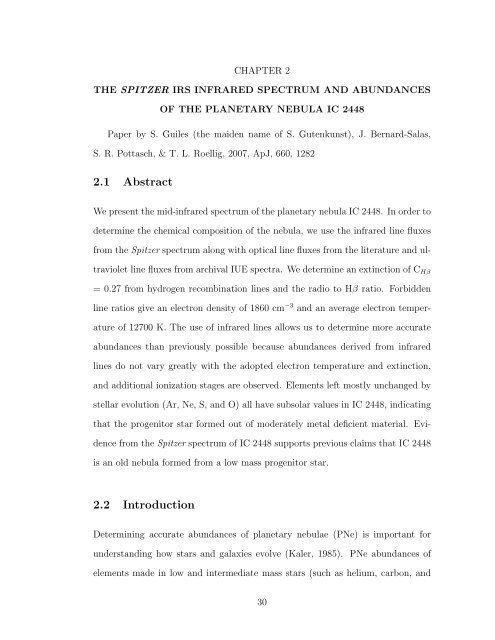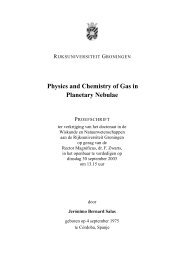TRACING ABUNDANCES IN GALAXIES WITH THE SPITZER ...
TRACING ABUNDANCES IN GALAXIES WITH THE SPITZER ...
TRACING ABUNDANCES IN GALAXIES WITH THE SPITZER ...
You also want an ePaper? Increase the reach of your titles
YUMPU automatically turns print PDFs into web optimized ePapers that Google loves.
CHAPTER 2<br />
<strong>THE</strong> <strong>SPITZER</strong> IRS <strong>IN</strong>FRARED SPECTRUM AND <strong>ABUNDANCES</strong><br />
OF <strong>THE</strong> PLANETARY NEBULA IC 2448<br />
Paper by S. Guiles (the maiden name of S. Gutenkunst), J. Bernard-Salas,<br />
S. R. Pottasch, & T. L. Roellig, 2007, ApJ, 660, 1282<br />
2.1 Abstract<br />
We present the mid-infrared spectrum of the planetary nebula IC 2448. In order to<br />
determine the chemical composition of the nebula, we use the infrared line fluxes<br />
from the Spitzer spectrum along with optical line fluxes from the literature and ul-<br />
traviolet line fluxes from archival IUE spectra. We determine an extinction of CHβ<br />
= 0.27 from hydrogen recombination lines and the radio to Hβ ratio. Forbidden<br />
line ratios give an electron density of 1860 cm −3 and an average electron temper-<br />
ature of 12700 K. The use of infrared lines allows us to determine more accurate<br />
abundances than previously possible because abundances derived from infrared<br />
lines do not vary greatly with the adopted electron temperature and extinction,<br />
and additional ionization stages are observed. Elements left mostly unchanged by<br />
stellar evolution (Ar, Ne, S, and O) all have subsolar values in IC 2448, indicating<br />
that the progenitor star formed out of moderately metal deficient material. Evi-<br />
dence from the Spitzer spectrum of IC 2448 supports previous claims that IC 2448<br />
is an old nebula formed from a low mass progenitor star.<br />
2.2 Introduction<br />
Determining accurate abundances of planetary nebulae (PNe) is important for<br />
understanding how stars and galaxies evolve (Kaler, 1985). PNe abundances of<br />
elements made in low and intermediate mass stars (such as helium, carbon, and<br />
30













